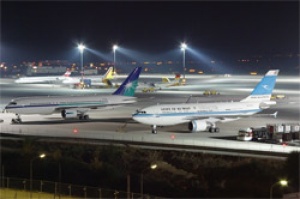European Commission gives Manchester Airport new body scanner permission

Manchester Airport’s Terminal 2 will become the first in Europe to replace hand searching with body scanners as part of the security process after airport bosses secured a unique agreement from the European Commission.
The move follows a successful trial of a body scanner in Terminal 2 that began in October 2009 and which became a compulsory part of secondary security screening in February 2010.
This means that from today in Terminal 2 only, the scanners will be deployed as part of a 12-month trial, replacing the second walk through metal detector. The airport is aiming to demonstrate to customers that they can keep their coats, jackets and shoes thus improving their journey through the security process.
The airport has been trialling a new SMART lane layout and this will complement the use of the scanners improving flow rate and ensuring passenger experience is reinforced.
The scanners will not be installed in Terminals 1 and 3 as originally announced, until the results of the new trial in T2 are ascertained. This follows the success of the partial trial that started last October and also follows the foiled terrorist attack to bring down a US flight to Detroit, after which scanners were made mandatory in the UK.
ADVERTISEMENT
Following the successful trial and the subsequent decision after the Christmas Day bomb, Manchester Airport always envisaged that more Imaging Technology units would be stationed in the remaining terminals at Manchester Airport. Scanners are already in place at Heathrow and other UK airports are bringing them online throughout the year.
Since February of 2010, new security rules on body scanners made it mandatory for any passengers who are selected for a scan to participate. Under the new rules, any refusal to be body scanned results in passengers not being allowed to travel.
The model used at Manchester is the Secure 1000 Single Pose, which has already been approved by the U.S. Transportation Security Administration and is currently being deployed at airports in the U.S. The Secure 1000 uses advanced x-ray backscatter technology and image processing software to detect potential threats on passengers at aviation checkpoints. The Secure 1000 Single Pose is designed to help security teams detect potential threat objects concealed on passengers.
Sarah Barrett, Head of Customer Experience at Manchester Airport, said: “The decision gives us an opportunity to improve our security procedure for the benefit of our customers which is exactly why we began using the scanner back in October. So far over 40,000 people have been through the scanner and it’s becoming another vital part of the security procedure here at Manchester. We have continued to reiterate that the image generated cannot be stored or captured nor can security officers viewing the images recognise people. The decision from the European Commission means that we can use the scanners as we originally envisaged to quicken the process for our customers.”
The introduction of a range of new security measures over the last few months has seen official visitors to the airport from other airport security colleagues from as far afield as Nigeria, Tunisia, Jordan and the USA. The Department for Transport have also praised the security operation at Manchester as one of the best in the country.
Manchester Airport will be providing passengers travelling through the terminals with detailed information about the introduction of body scanners.

